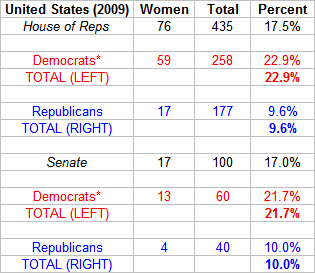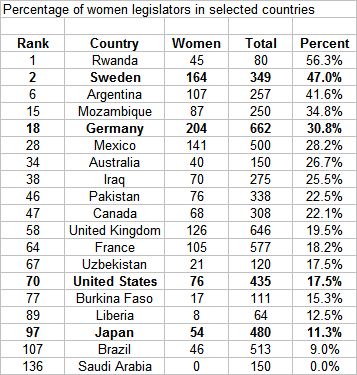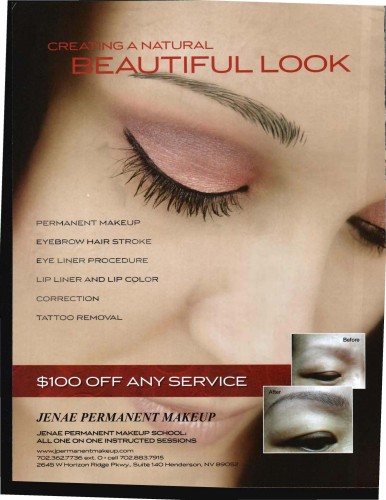FiveThirtyEight has up an interesting article about the proportion of Republicans in the U.S. Congress who are women, as well as comparisons to conservative parties in several other countries. The U.S. data (note that, contrary to the usual color-coding, in these tables red = left and blue = right, and an * indicates it is the party in power):

Now, one obvious explanation for this data would be that there aren’t that many women in the Republican party compared to the Democratic party, so there are accordingly fewer women in Congress (anyone have data on the gender breakdown by party, as opposed to voting in particular elections?). Or maybe they just can’t get elected. Another would be that parties on the right often encourage gender roles that are more “traditional,” with the idea that public life (particularly politics) is more appropriate for men, while women focus more on the private sphere of home life and extensions of it (say, education).
There may very well be some truth there, but that’s not the whole story. For one thing, the U.S. lags behind many other nations in terms of the percent of female legislators (a pattern that holds in the U.S. whether Republicans or Democrats control Congress, though the % changes somewhat):

The FiveThirtyEight post also compares parties in Sweden, Japan, Germany, and the U.S. in terms of the representation of women in left- and right-leaning parties, based on data for the parties holding seats in the legislative bodies in each country. In Sweden a center/right coalition is currently in power, while in Germany a left-leaning and right-leaning party have formed a coalition. A party on the left recently took power from a party on the left in Japan. A comparison of the four countries, broken down by political orientation:

Of course, parties on the right and left in each nation have different platforms, policy emphases, bases of support, and gender ideologies, so they aren’t directly comparable. But the “proportion” column above compares left and right parties within each country; it reflects the % of right party legislators that is female compared to the % in more left-leaning parties. That is, if the parties on the political right had the same % of female legislators as parties on the political left in that country, the proportion would be 100.0%. The lower the proportion, the lower the % of female legislators on the right compared to their representation on the left.
As we see, there are clear differences by political orientation in all countries, but there is an enormous range. The U.S. stands out with a particularly low proportion, indicating the largest gap between right and left parties.
Of course, the other story here is that both the U.S. and Japan stand out with extremely low percentages of legislators who are women in either party, with Germany doing better but still lagging compared to the proportion of women in the population. On the other hand, both left and right parties in Sweden seem to be capable of recruiting women who run for national office and win.





